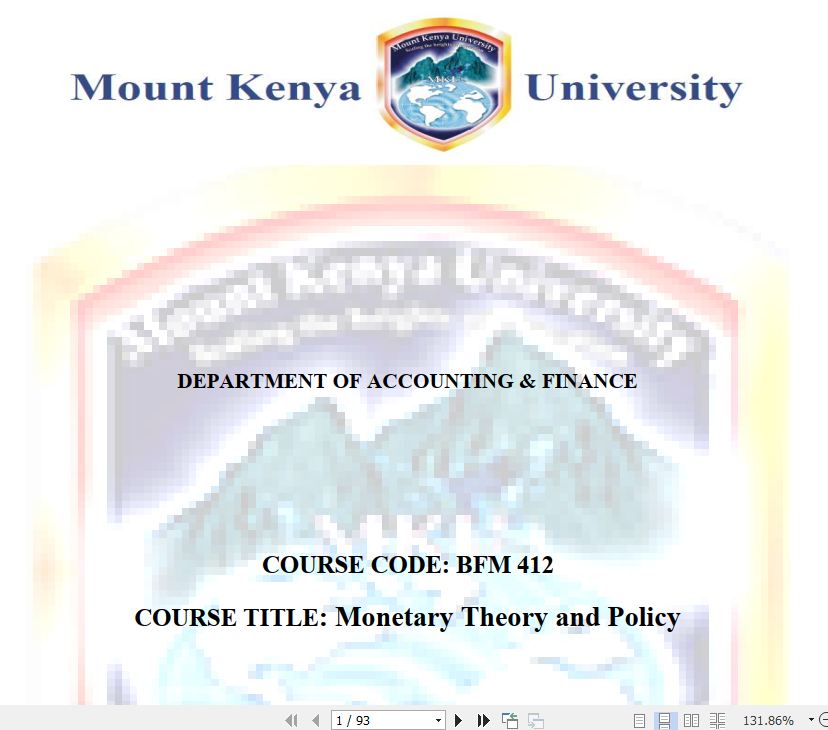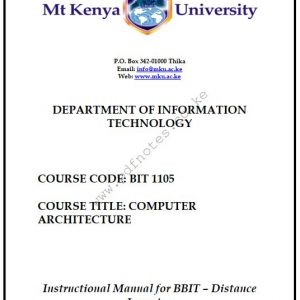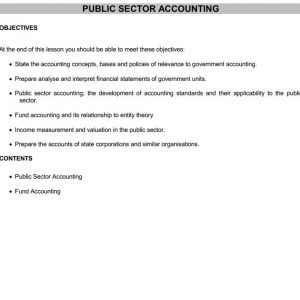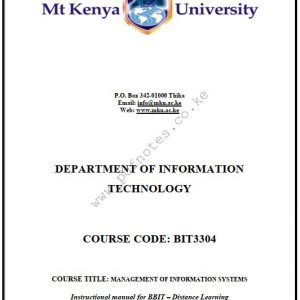Description
Course content
CHAPTER ONE1
MONEY AND BANKS
INTRODUCTION
1.1 Money
1.2 Functions of money
1.3 Physical properties of money
1.4 Review questions
CHAPTER TWO
FINANCIAL MARKETS, FINANCIAL INSTITUTIONS AND FINANCIAL INSTRUMENTS
2.1 Financial markets
Classification of financial markets
2.2 Financial instruments
Money market instruments
2.2.2 Capital market instruments
Review questions
Reference
CHAPTER THREE
MONEY DEMAND AND MONEY SUPPLY
3.1 Money demand
3.1.2 The classical view of money demand
3.1.2 Keynes’s view of money demand
3.2 Money supply
100-percent reserve banking
3.2.2 Fractional-reserve banking
3.2.3 A model of the money supply
Review questions
Reference
CHAPTER FOUR
MONEY AND INFLATION
4.1 Difference between inflation and economic growth
4.2 The price level and real output
4.2.1 Measuring the price level
4.2.2 Measuring nominal and real output
4.3 Inflation and economic growth
Inflation
4.3.2 Economic growth
The relationship between inflation and economic growth
4.5 Causes of inflation
4.5.1 Growth in the money stock
4.5.2 Velocity and economic growth
Review questions
Reference
CHAPTER FIVE
CENTRAL BANKING
5.0 Introduction
5.1 What are the main functions of a central bank?
5.2 Major macro-economy policies
5.3 Monetary policy
5.4 Monetary policy functions of a central bank
5.4.1 Monetary policy objectives
5.4.2 Instruments of monetary policy
5.5 Why do banks need a central bank?
5.6 Should central banks be independent?
5.7 REVIEW QUESTIONS
Reference
CHAPTER SIX
AGGREGATE DEMAND (AD) AND AGGREGATE SUPPLY (AS)
6.1 The model of aggregate supply and aggregate demand
6.1.1 Aggregate demand (AD)
Why the aggregate demand curve slopes downward?
Why the aggregate demand curve might shift?
6.1.2 Aggregate supply
The Aggregate supply curve
Why the aggregate supply curve is vertical in the long-run?
Why the long-run aggregate supply curve might shift?
Why the aggregate supply curve slopes upward in the short-run
6.2 REVIEW QUESTIONS
Reference
CHAPTER SEVEN
ANALYSIS OF SHIFTS IN AGGREGATE DEMAND AND/OR AGGREGATE SUPPLY
7.1 THE EFFECTS OF A SHIFT INAGGREGATE DEMAND
What should policymakers do when faced with such recession?
7.2 THE EFFECTS OF A SHIFT IN AGGREGATE SUPPLY
What should policymakers do when faced with stagflation?
7.3 THE INFLUENCE OF MONETARY AND FISCAL POLICY ON AGGREGATE DEMAND
7.3.1 How monetary policy influences aggregate demand.
The theory of liquidity preference
7.3.2 Equilibrium in the money market
7.4 THE DOWNWARD SLOPE OF THE AGGREGATE DEMAND CURVE
Review questions
Reference
CHAPTER EIGHT
THE IS-LM MODEL AND AGGREGATE DEMAND
8.0 Introduction
8.1 The IS-curve
Factors that shifts the IS-curve
8.2 The LM-curve
Factors that shift LM-curve
8.3. General equilibrium
8.4 IS-LM model and aggregate demand
Review questions
CHAPTER NINE
FORMATION OF FUTURE EXPECTATION
9.0 Introduction
8.1 Three theories of expectation formation
MARKOV EXPECTATIONS
ADAPTIVE EXPECTATIONS
RATIONAL EXPECTATIONS
8.2 Rational Expectation and the Efficient Market Hypothesis
Review questions






Reviews
There are no reviews yet.